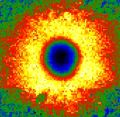Speaker
Description
Metal halide perovskites (MHPs) have interesting properties, especially for photovoltaic applications, such as high charge carrier mobility, strong optical absorption, long free carrier diffusion length, as well as their cost-effective and easy solution process manufacture and defect tolerance [1]. Nevertheless, the non-radiative recombination caused by defects is still the dominant factor limiting the performance of photovoltaic devices. Defect passivation has been proven to be an efficient strategy to suppress the non-radiative recombination. But to design a specific and effective passivation technique, it is crucial to distinguish between surface and bulk defects, which is not possible by conventional measurement techniques.
In our work, transverse photothermal deflection spectroscopy (PDS) is used to study the absorption spectra of MAPbBr3 single crystals. Bulk and surface defects were introduced by bismuth doping and light exposure, respectively. PDS is a highly sensitive technique that measures the absorbance of semiconducting materials, even in the deep sub-bandgap region. PDS is a pump-probe, lock-in based technique. Pump beam is mechanically chopped and focused on the sample, which is immersed in a medium with high thermo-optical coefficient. Probe beam, propagating through this medium close to the sample surface, is deflected by thermally induced change of refractive index. This change of refractive index is caused by heat generation from relaxation and nonradiative recombination processes inside the sample. The "thermal depth" i.e., the depth out of which the thermal signal is able to propagate to the surface and be detected, can be increased by changing the chopping frequency. The actual "probed depth" i.e., the depth in which the detected signal is generated, is determined by the phase shift between the pump beam and the detected signal. The phase shift increases when signal is generated in greater depths and decreases when the signal is generated closer to the surface. Based on this information we are able to distinguish between defects localized at the surface and defects distributed homogeneously within the bulk of MHP SC. That is crucial information when designing a specific passivation strategy for those materials.
[1] Ledinsky, M.; Schönfeldová, T.; Holovský, J.; Aydin, E.; Hájková, Z.; Landová, L.; Neyková, N.; Fejfar, A.; De Wolf, S. Temperature Dependence of the Urbach Energy in Lead Iodide Perovskites. J. Phys. Chem. Lett. 2019, 10 (6), 1368–1373. https://doi.org/10.1021/acs.jpclett.9b00138.

